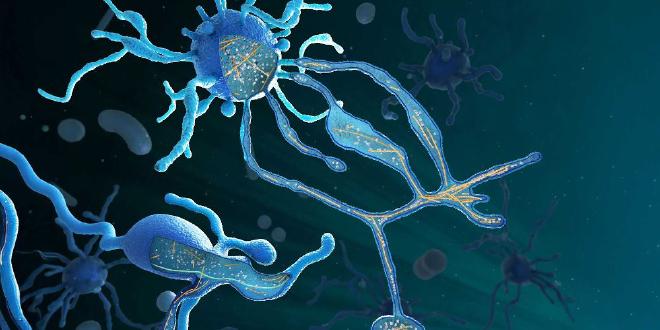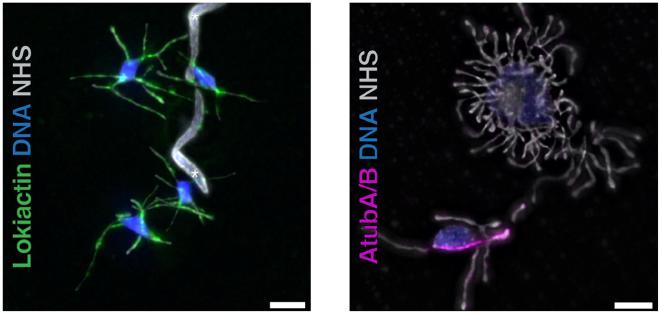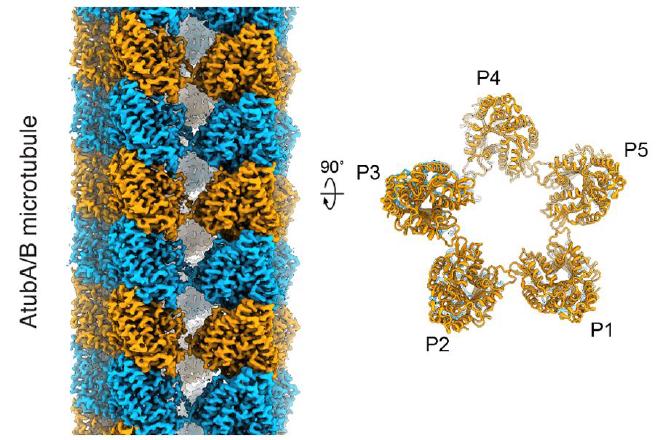

Ten years ago, nobody knew that Asgard archaea even existed. In 2015, however, researchers examining deep-sea sediments discovered gene fragments that indicated a new and previously undiscovered form of microbes.
With computer assistance, the researchers assembled these fragments like puzzle pieces to compile the entire genome. It was only then that they realized they were dealing with a previously unknown group of archaea.
After a further search, microbiologists identified the corresponding organisms, described them and classified them as a separate archaeal sub-group: Asgard archaea. Their name, taken from the heavenly realm in Norse mythology, references their initial discovery close to Loki’s Castle – a black smoker on the mid-Atlantic ridge between Norway and Svalbard.
In fact, Asgard archaea appeared almost heaven-sent for research: they turned out to be a missing link between archaea and eukaryotes – that is, between archaea and organisms whose cells contain a nucleus, such as plants and animals.
Tree of life with one branch fewer #
In recent years, researchers have found growing indications of close links between Asgard archaea and eukaryotes, and that the latter may have evolved from the former. The division of all living organisms into the three domains of bacteria, archaea and eukaryotes did not hold up to this surprising discovery.
Some researchers have since proposed regarding eukaryotes as a group within Asgard archaea. This would reduce the number of domains of life from three to two: archaea, including eukaryotes, and bacteria.

At ETH Zurich, Professor Martin Pilhofer and his team are fascinated by Asgard archaea and have examined the mysterious microbes for several years.
In an article published in Nature two years ago, the ETH researchers explored details of the cellular structure and architecture of Lokiarchaeum ossiferum. Originating in the sediments of a brackish water channel in Slovenia, this Asgard archaeon was isolated by researchers in Christa Schleper’s laboratory at the University of Vienna.
In that study, Pilhofer and his postdoctoral researchers Jingwei Xu and Florian Wollweber demonstrated that Lokiarchaeum ossiferum possesses certain structures also typical of eukaryotes. “We found an actin protein in that species that appears very similar to the protein found in eukaryotes – and occurs in almost all Asgard archaea discovered to date,” Pilhofer said.
First study #
In the first study, the researchers combined different microscopy techniques to demonstrate that this protein – called Lokiactin – forms filamentous structures, especially in the microbes’ numerous tentacle-like protrusions. “They appear to form the skeleton for the complex cell architecture of Asgard archaea,” added Florian Wollweber.
In addition to actin filaments, eukaryotes also possess microtubules. These tube-shaped structures are the second key component of the cytoskeleton and are comprised of numerous tubulin proteins. These tiny tubes are important for transport processes within a cell and the segregation of chromosomes during cell division.
A new study #
The origin of these microtubules has been unclear – until now. In a newly published article in Cell , the ETH researchers discovered related structures in Asgard archaea and describe their structure. These experiments show that Asgard tubulins form very similar microtubules, albeit smaller than those in their eukaryotic relatives.
However, only a few Lokiarchaeum cells form these microtubules. And, unlike actin, these tubulin proteins only appear in very few species of Asgard archaea.

Scientists do not yet understand why tubulins appear so rarely in Lokiarchaea, or why they are needed by cells. In eukaryotes, microtubuless are responsible for transport processes within the cell. In some cases, motor proteins “walk along” these tubes. The ETH researchers have not yet observed such motor proteins in Asgard archaea.
“We have shown, however, that the tubes formed from these tubulins grow at one end. We therefore suspect that they perform similar transport functions as the microtubules in eukaryotes,” said Jingwei Xu, the co-first author of the Cell study. He produced the tubulins in a cell culture with insect cells and examined their structure.
Researchers from the fields of microbiology, biochemistry, cell biology and structural biology collaborated closely on the study. “We would never have progressed so far without this interdisciplinary approach,” emphasized Pilhofer with a degree of pride.

Was the cytoskeleton essential for the development of complex life? While some questions remain unanswered, the researchers are confident that the cytoskeleton was an important step in the evolution of eukaryotes.
This step could have occurred aeons ago, when an Asgard archaeon entwined a bacterium with its appendages. In the course of evolution, this bacterium developed into a mitochondrion, which serves as the powerhouse of modern cells. Over time, the nucleus and other compartments evolved – and the eukaryotic cell was born.
“This remarkable cytoskeleton was probably at the beginning of this development. It could have enabled Asgard archaea to form appendages, thereby allowing them to interact with, and then seize and engulf a bacterium,” stated Pilhofer.
Fishing for Asgard archaea #
Pilhofer and his colleagues now plan to turn their attention to the function of actin filaments and archaeal tubulin along with the resulting microtubules.
They also aim to identify the proteins that researchers have discovered on the surface of these microbes. Pilhofer hopes his team will be able to develop antibodies precisely tailored to these proteins. This would enable researchers to “fish” specifically for Asgard archaea in mixed microbe cultures.
“We still have a lot of unanswered questions about Asgard archaea, especially regarding their relation to eukaryotes and their unusual cell biology,” said Pilhofer. “Tracking down the secrets of these microbes is fascinating.”
Abstract #
-
Asgard archaea are a group of microorganisms discovered just ten years ago. They represent a link between bacteria, archaea and complex organisms, such as plants and animals.
-
ETH researchers have now conducted a detailed examination of one such microbe, Lokiarchaeum ossiferum, and discovered cytoskeletal proteins very similar to those found in complex organisms.
-
As a result, it appears increasingly clear that Asgard archaea are ancestors of humans, animals and plants.
-
The paper Microtubules in Asgard archaea was published in Cell. Authors: Florian Wollweber, Jingwei Xu (许靖蔚), Rafael I. Ponce-Toledo, Florina Marxer, Thiago Rodrigues-Oliveira, Anja Pössnecker, Zhen-Hao Luo (罗振豪), Jessie James Limlingan Malit, Anastasiia Kokhanovska, Michal Wieczorek, Christa Schleper & Martin Pilhofer.
-
Funding: This work was supported by an ETH Zürich Career Seed Award (to F.W.), an SNSF SPARK grant (229135 to F.W.), an ETH Zürich Research Grant (22 22-1 to M.W.), SNSF Project Grants (310030_208120 to M.W. and 10002842 to M.P.), an SNSF Starting Grant (TMSGI3_211309 to M.W.), the Austrian Science Fund (FWF Z437 to C.S.), the European Research Council (AdG TACKLE 695192 to C.S. and CoG Cryo-ET4Diversity 101000232 to M.P.), and the NOMIS Foundation (to M.P.).
-
The paper Actin cytoskeleton and complex cell architecture in an Asgard archaeon was published in Nature on December 21 2022. Authors: Thiago Rodrigues-Oliveira, Florian Wollweber, Rafael I. Ponce-Toledo, Jingwei Xu, Simon K.-M. R. Rittmann, Andreas Klingl, Martin Pilhofer & Christa Schleper.
-
Funding: C.S. was supported by the European Research Council (AdG TACKLE, 695192) and the Austrian Science Fund (FWF): W1257. M.P. was supported by the European Research Council (CoG CryoET4Diversity, 101000232) and the NOMIS Foundation.
-
The article Origin of Life: How microbes laid the foundation for complex cells written by Peter Rüegg, Corporate Communications was published in ETH Zurich’s website news section
Contact: notaspampeanas@gmail.com

